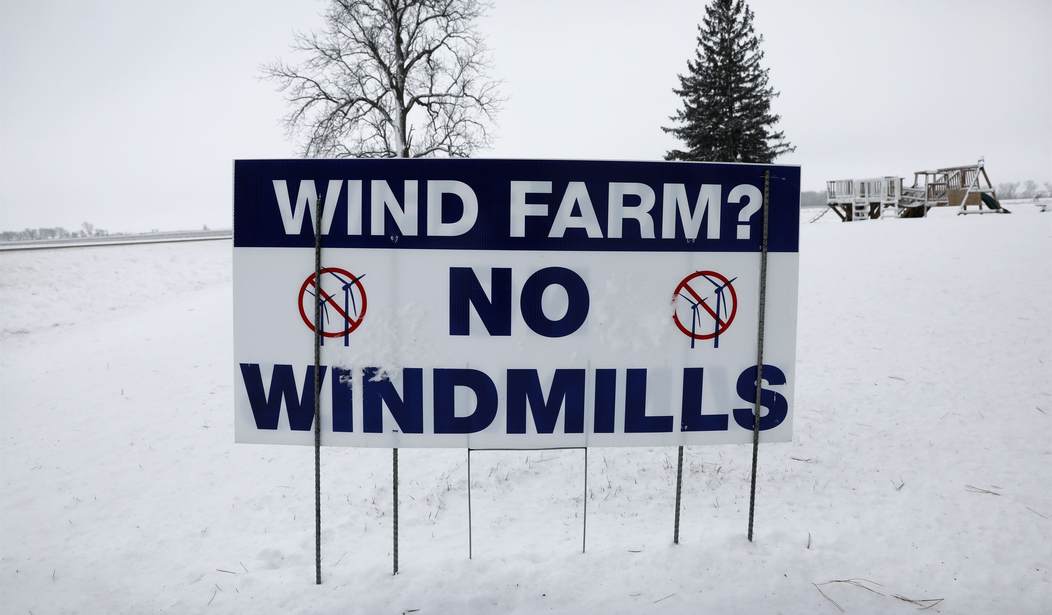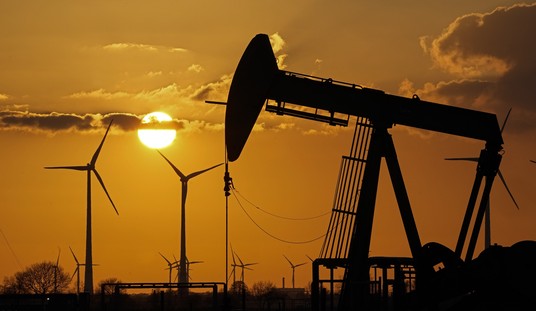This was a welcome bit of news to stumble over.
Back in June, I told you all about a YUGE wind farm project the Bureau of Land Management had their sticky fingers in planned for federal land in an isolated section of Idaho.
As originally planned, the wind farm project christened "Lava Ridge" was going to be built on almost 200,000 acres in southern Idaho. Most of those would federal lands managed by the Bureau of Land Management (BLM).
...The Lava Ridge Wind Project would consist of 400 turbines up to 740 feet in height and the associated infrastructure, including new roads, powerlines, substations, maintenance facilities and battery storage facilities. It would be located 25 miles northeast of Twin Falls.
The government bureaucrats were under the impression that, since they controlled all that land, it would be pretty much a done deal. One rarely wins against them if they're crazy enough to push back, and besides, who was out in that God-forsaken corner of nowhere to squawk about it anyway?
Much to the BLM's surprise, folks came out of the woodwork with objections and legitimate ones at that (over 11K of them received), just that fast.
Part of it was plain old irritation that their pristine next of the backwoods would be despoiled for electricity generation that would be sold to California. None of it would benefit their corner of Idaho in any way.
Some of the most concerned were farmers and ranchers in the area who had already been stung by a recently announced state water curtailment in that area. The state was going to cut them off from their aquifer in short order if their water mitigation plans weren't brought up to snuff within two weeks.
...In fact, at the end of May and only a week before the BLM announced their decision, the state of Idaho announced a water curtailment plan for that very Magic Valley region among 5 other districts. The state was literally going to shut the water off if those offending districts didn't come up to snuff on their water mitigation plans in two weeks' time.
Idaho Department of Water Resources Director Mathew Weaver issued a curtailment order Thursday afternoon that requires 6,400 junior groundwater rights holders who pump off the Eastern Snake Plain Aquifer to shut off their water.
Mind you, this was without the projected wind farm being completed and then draining its projected share of those same scarce water resources.
...Millions of gallons would be drawn from new wells to be used in everything from pouring concrete to spraying roads for dust and the water needed to change the oil in the turbines once they're operational. A little over a year ago, estimates were over 125M gallons for the life of the project for one of the proposed layouts.
...Regarding water resources for the Lava Ridge project, Alternative C would use a total of 126.2 million gallons from the construction phase through decommissioning, an estimated period of 34 years. Alternative E would use about 92 million gallons.
As you can imagine, in a rural state, the Schlitz hit the fan as, besides the country folks, some big industrial names were fixin' to also take a severe hit from curtailing the water, and it took the governor intervening before the water board backed down.
Idaho Department of Water Resources Director Mathew Weaver has lifted a curtailment order that could have shut off water to many irrigators in eastern and south-central Idaho.
...“Obviously, we’re glad to see it reversed,” said Keith Esplin, executive director of the Eastern Idaho Water Rights Coalition and Eastern Snake Plain Aquifer Recharge.
But groundwater users are concerned. This is the second straight year in which the department forecast a shortfall in the spring, and then it vanished, he said.
“But it doesn’t go away,” he said.
Groundwater districts spent money to line up water supplies or committed to water purchases for senior water right holders. And there’s been some unsubstantiated reports that some farmers turned off water under threat of a $300 an acre fine, causing crop damage, he said.
Anheuser-Busch in Idaho Falls would have had to shut down its plant or face a $53,000 fine. But it would have lost $5 million to $7 million in lost product, he said.
In the best government fashion, they put a decision off until "next year."
The wind company did some fancy tap-dancing of their own trying to placate locals but it only served to make people even more suspicious. A state senator representing the area was rubbing her chin just prior to the waterboard rescinding the curtailment as BLM sent around an email reducing the area requirements for the wind farm.
“The preferred alternative reduces the area disturbed from the initial proposal by 50 percent, lowers the number of turbines from 400 to 241 to remove the most sensitive locations, and imposes maximum height limits of 660 feet for turbines (instead of 700 feet).”
I have to wonder if this was not Magic Valley Energy’s goal all along. Why would they be okay with fifty percent less revenue? I am still a firm NO, especially now that our Idaho farmers are being told their water will be curtailed.
Another reason emerging for the BLM's shrinkage of the property was its visual and possible aural impact on the Minidooka National Historic Site - one of the Japanese internment camps of WWII disgrace.
The BLM, in its final decision, had said the project would go forward in its revised, downsized version.
TOO BAD FOR YOU
The decision brought with it closure in one sense that this was the project's final form, but also in another in that everyone with objections now had a hard target to aim lawsuits and protest actions at. The water issue wasn't resolved satisfactorily for anyone, but the Minidoka Camp?
Well, the BLM arrogant as it is, has to work with some called the National Advisory Council on Historic Preservation if any of their proposed projects impact - in any way - national historic sites. And the group managing Minidoka was determined to make sure the NACHP knew exactly what the BLM was planning to do on the ridges around their site.
Last week, the Idaho delegation sent a letter to the council supporting the efforts of the Minidoka advocates.
...The delegation expressed concerns over the potential impact of the proposed wind energy project on the Minidoka National Historic Site, which commemorates the internment of Japanese Americans during World War II. In a written statement, the Idaho lawmakers emphasized the importance of preserving the integrity of the site, which they argue would be "irreparably altered" if the Lava Ridge project were to proceed.
“Unfortunately, the views of these stakeholders—Minidoka survivors, descendants, and allies, along with the vast majority of Idahoans—have been largely disregarded," the delegation wrote. "Maintaining the sanctity of Minidoka is not a matter that can be mitigated elsewhere."
The Idaho lawmakers are asking ACHP to halt its consultation process with the BLM and to use available mechanisms to prevent a Record of Decision from being issued by the BLM until ACHP has fully considered and addressed concerns raised about the project’s proximity to the historic site.
Not two days later the hammer came down on the BLM.
The Bureau of Land Management’s efforts to approve a major wind power project in southern Idaho has suffered a setback, and its fate is now up in the air.
The federal Advisory Council on Historic Preservation notified BLM on Friday it is terminating efforts to work out a programmatic agreement on the Lava Ridge Wind Project, saying it cannot ensure the project won’t cause damage to the nearby Minidoka National Historic Site.
The ACHP’s decision, outlined in a letter to BLM’s acting Idaho Director Peter Ditton, is a black eye for BLM, which in June advanced the project in a final analysis that dramatically scaled back the proposal specifically to avoid impacts to the site where thousands of Japanese Americans were incarcerated during World War II.
Now, the BLM can still proceed, but they have to do some serious paperwork justifying going ahead without the ACHP blessing.
...Despite the setback, the bureau can still approve the project in a record of decision that was set to be issued in the coming weeks.
But BLM Director Tracy Stone-Manning will now have to first address in writing ACHP’s concerns and outline a plan to ensure that the project — which would rank among the largest wind farms in North America — can be built and operated in a way that protects the National Park Service-managed Minidoka site.
What will the BLM ultimately decide to do?
This is an election year, after all, which might give them some pause.
Might.
God forbid, Kamala wins, because the entire West is under Green assault.
Several Native American Tribes in Nevada fear a new solar development plan created by the federal government could lead to utility scale solar projects on the site of the proposed Bahsahwahbee national monument.
Last week, the U.S. Bureau of Land Management released their long-anticipated Western Solar Plan, a roadmap that will set the trajectory for solar energy development across 11 western states for the next two decades.
Under the plan, about 12 million acres of public land in Nevada would be available for solar development. Utility scale solar developments would be permitted up to 15 miles from existing and planned transmission lines or designated energy corridors, as well as on previously disturbed lands.
There won't be anything to stop them is we don't do it November 5th.







Join the conversation as a VIP Member